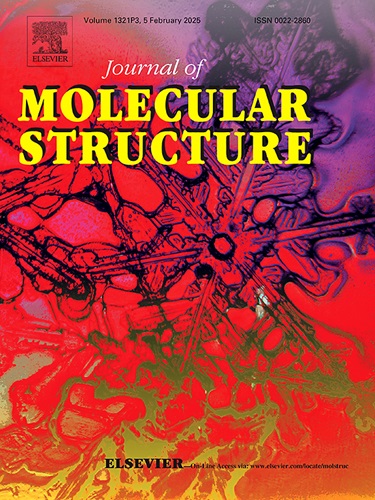Synthetic routes for novel annulated chromeno[3,2:5,6]pyrido[2,3-d] imidazo[1,2-a]pyrimidines: Design, characterization, antimicrobial efficiency and theoretical studies
IF 4
2区 化学
Q2 CHEMISTRY, PHYSICAL
引用次数: 0
Abstract
The novel annulated chromeno[3,2:5,6]pyrido[2,3-d]imidazo[1,2-a]pyrimidines 4–7 were efficiently synthesized from condensation reaction of the key precursor 3 with a variety of 1,2-bielectrophilic reagents namely 1,2-dichloroethane, oxalyl chloride, chloroacetic acid and chloroacetone. The antimicrobial activity of the prepared compounds in vitro against some microbial strains revealed significant efficiency especially compounds 5 and 7. Using analytical and spectral results, the structures of the synthesized products were established. DFT/B3LYP/6–311++G(d,p) basis set was used to compute HOMO and LUMO energies and global reactivity descriptors. Compound 1 has the largest HOMO–LUMO energy gap, whereas compound 5 has the smallest one. The Fukui functions (FFs) for the starting substrate 3 were calculated using the same level of theory to identify the more active sites during the chemical reactions. Molecular electrostatic potential (MEP) diagram displayed the susceptible locations for attack by electrophiles and nucleophiles. The B3LYP/6311++G(d,p) method was used to compute vibrational wavenumbers, and the results were compatible with the experimental data. Also, the 13C and 1H NMR chemical shifts were estimated using the Gauge-independent atomic orbital (GIAO) approach and the results compared with the experimental data presenting excellent agreement. To explain the nonlinear optical (NLO) properties of the synthesized compounds, the dipole moment, polarizability, and first hyperpolarizability values were calculated and compared with urea as a reference material. ADME calculations were performed using the SwissADME method, which revealed that the present heterocyclic systems have safe physicochemical properties.

新型环状吡啶[3,2:5,6]吡啶[2,3-d]咪唑[1,2-a]嘧啶的合成路线:设计、表征、抑菌效果及理论研究
以关键前驱体3为原料,与1,2-二氯乙烷、草酰氯、氯乙酸和氯丙酮等1,2-亲电试剂进行缩合反应,合成了新型环状吡啶[3,2:5,6][2,3-d]咪唑[1,2-a]嘧啶4-7。所制备的化合物对一些微生物的体外抑菌活性显示出显著的效果,特别是化合物5和7。利用分析和光谱结果确定了合成产物的结构。采用DFT/B3LYP/ 6-311 ++G(d,p)基集计算HOMO和LUMO能量和全局反应性描述符。化合物1的HOMO-LUMO能隙最大,而化合物5的HOMO-LUMO能隙最小。用相同的理论水平计算起始底物3的福井函数(FFs),以确定化学反应中更活跃的位点。分子静电势(MEP)图显示了亲电试剂和亲核试剂攻击的易感部位。采用B3LYP/6311++G(d,p)方法计算振动波数,结果与实验数据相符。此外,利用非量规原子轨道(GIAO)方法估计了13C和1H核磁共振化学位移,并将结果与实验数据进行了比较,结果具有很好的一致性。为了解释合成的化合物的非线性光学性质,计算了偶极矩、极化率和第一超极化率值,并与尿素作为参考物质进行了比较。采用SwissADME方法进行了ADME计算,结果表明该杂环体系具有安全的物理化学性质。
本文章由计算机程序翻译,如有差异,请以英文原文为准。
求助全文
约1分钟内获得全文
求助全文
来源期刊

Journal of Molecular Structure
化学-物理化学
CiteScore
7.10
自引率
15.80%
发文量
2384
审稿时长
45 days
期刊介绍:
The Journal of Molecular Structure is dedicated to the publication of full-length articles and review papers, providing important new structural information on all types of chemical species including:
• Stable and unstable molecules in all types of environments (vapour, molecular beam, liquid, solution, liquid crystal, solid state, matrix-isolated, surface-absorbed etc.)
• Chemical intermediates
• Molecules in excited states
• Biological molecules
• Polymers.
The methods used may include any combination of spectroscopic and non-spectroscopic techniques, for example:
• Infrared spectroscopy (mid, far, near)
• Raman spectroscopy and non-linear Raman methods (CARS, etc.)
• Electronic absorption spectroscopy
• Optical rotatory dispersion and circular dichroism
• Fluorescence and phosphorescence techniques
• Electron spectroscopies (PES, XPS), EXAFS, etc.
• Microwave spectroscopy
• Electron diffraction
• NMR and ESR spectroscopies
• Mössbauer spectroscopy
• X-ray crystallography
• Charge Density Analyses
• Computational Studies (supplementing experimental methods)
We encourage publications combining theoretical and experimental approaches. The structural insights gained by the studies should be correlated with the properties, activity and/ or reactivity of the molecule under investigation and the relevance of this molecule and its implications should be discussed.
 求助内容:
求助内容: 应助结果提醒方式:
应助结果提醒方式:


